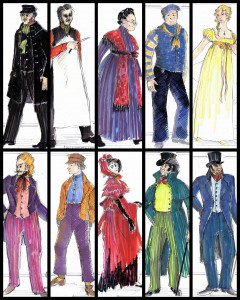 I’ve spent the last few weeks combing Sondheim’s Finishing the Hat. In the preface to the Sweeney Todd chapter, the composer writes:
I’ve spent the last few weeks combing Sondheim’s Finishing the Hat. In the preface to the Sweeney Todd chapter, the composer writes:
“Sweeney Todd has been called by people who care about categories everything from an opera to a song cycle. When pressed, I have referred to it as a dark operetta, but just as all baggage comes with labels, so do all labels come with baggage. “Opera” implies endless stentorian singing, “operetta” implies gleeful choirs of peasants dancing in the town square, “opera bouffe” implies hilarious (in intent, at least) complications of mistaken identity, “musical comedy” implies showbiz pizzazz and blindingly bright energy, “musical play” implies musical comedy that isn’t funny. For me, an opera is something that is performed in an opera house in front of an opera audience…. So where does that leave Sweeney? “Dark operetta” is the closest I can come, but that’s as much a misnomer as any of the others. What Sweeney Todd really is is a movie for the stage.”
In this corner of the opera world, we do battle every day to make sure that opera is more than “endless stentorian singing.” There seems to be no discernible way to navigate without these labels, but they really do more harm than good in our time.
Meanwhile, back in the real world of the rehearsal room, where there’s little time for philosophizing, we ran Act I for the first time after the first 7 days of rehearsal. I was once again struck dumb by the genius in this piece, and energized by what these singers are doing with it.
Sweeney costume sketches above courtesy of designer Rooth Varland
Add Comment